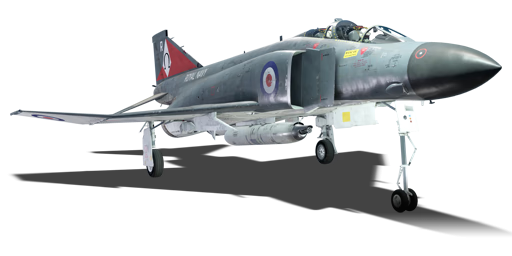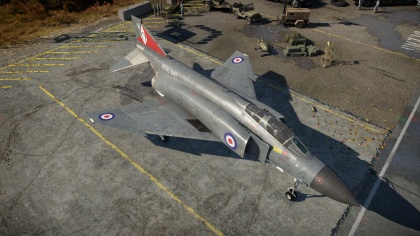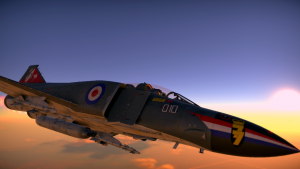Difference between revisions of "Phantom FG.1"
(Edits) |
(Removed - please do not put this on pages - anyone is allowed to edit the page.) |
||
| Line 1: | Line 1: | ||
| − | |||
{{Specs-Card|code=f-4k}} | {{Specs-Card|code=f-4k}} | ||
{{About | {{About | ||
Revision as of 11:04, 3 July 2020
Contents
| This page is about the jet fighter Phantom FG.1. For other versions, see F-4 Phantom II (Family). |
Description
The Phantom FG.1 is a rank VII British jet fighter
with a battle rating of 11.7 (AB), 12.0 (RB), and 11.3 (SB). It was introduced in Update "Starfighters".
General info
Flight performance
Describe how the aircraft behaves in the air. Speed, manoeuvrability, acceleration and allowable loads - these are the most important characteristics of the vehicle.
| Characteristics | Max Speed (km/h at 10,667 m) |
Max altitude (metres) |
Turn time (seconds) |
Rate of climb (metres/second) |
Take-off run (metres) | |||
|---|---|---|---|---|---|---|---|---|
| AB | RB | AB | RB | AB | RB | |||
| Stock | 2,195 | 2,158 | 16000 | 26.5 | 26.9 | 178.0 | 168.0 | 850 |
| Upgraded | ___ | ___ | __._ | __._ | __._ | __._ | ||
Details
| Features | |||||
|---|---|---|---|---|---|
| Combat flaps | Take-off flaps | Landing flaps | Air brakes | Arrestor gear | Drogue chute |
| X | ✓ | ✓ | ✓ | ✓ | ✓ |
| Limits | ||||||
|---|---|---|---|---|---|---|
| Wings (km/h) | Gear (km/h) | Flaps (km/h) | Max Static G | |||
| Combat | Take-off | Landing | + | - | ||
| 1458 | 463 | N/A | 625 | 463 | ~11 | ~4 |
| Optimal velocities (km/h) | |||
|---|---|---|---|
| Ailerons | Rudder | Elevators | Radiator |
| < 810 | < 750 | < 700 | N/A |
Engine performance
| Engine | Aircraft mass | |||||
|---|---|---|---|---|---|---|
| Engine name | Number | Empty mass | Wing loading (full fuel) | |||
| Rolls-Royce Spey 203 | 2 | 14,200 kg | 408 kg/m2 | |||
| Engine characteristics | Mass with fuel (no weapons load) | Max Takeoff Weight | ||||
| Weight (each) | Type | 7m fuel | 20m fuel | 26m fuel | ||
| 1,860 kg | Afterburning low-bypass turbofan | 15,807 kg | 18,707 kg | 20,055 kg | 25,400 kg | |
| Maximum engine thrust @ 0 m (RB / SB) | Thrust to weight ratio @ 0 m (WEP) | |||||
| Condition | 100% | WEP | 7m fuel | 20m fuel | 26m fuel | MTOW |
| Stationary | 5,110 kgf | 9,014 kgf | 1.14 | 0.96 | 0.90 | 0.71 |
| Optimal | 5,110 kgf (0 km/h) |
10,331 kgf (1,200 km/h) |
1.31 | 1.10 | 1.03 | 0.81 |
Survivability and armour
Examine the survivability of the aircraft. Note how vulnerable the structure is and how secure the pilot is, whether the fuel tanks are armoured, etc. Describe the armour, if there is any, and also mention the vulnerability of other critical aircraft systems.
Armaments
Suspended armament
The Phantom FG.1 can be outfitted with the following ordnance:
- 1 x 20 mm M61 cannon, belly-mounted (gunpod) (1,200 rpg)
- 8 x 1,000 lb G.P. Mk.I bombs + 1 x 20 mm M61 cannon, belly-mounted (gunpod) (1,200 rpg) (8,000 lb total)
- 108 x SNEB type 23 rockets + 1 x 20 mm M61 cannon, belly-mounted (gunpod) (1,200 rpg)
- 4 x AIM-9D Sidewinder missiles + 1 x 20 mm M61 cannon, belly-mounted (gunpod) (1,200 rpg)
- 4 x 1,000 lb G.P. Mk.I bombs + 4 x AIM-9D Sidewinder missiles + 1 x 20 mm M61 cannon, belly-mounted (gunpod) (1,200 rpg) (4,000 lb total)
- 4 x AIM-9D Sidewinder missiles
Usage in battles
The Phantom FG.1 is the ultimate energy fighter- its advantages over other aircraft are sheer power, roll rate, its unrivalled ability to climb to high altitudes, and its nearly unparalleled speed and thrust-to-weight ratio down low. The twin Rolls-Royce Spey 203 engines produce just over 9,000 kgf thrust when you are stationary- that is to say, on the runway- and over 10,000 kgf when you're travelling at near-supersonic speeds.
Side-climb high- around 8,000-9,000 metres will do- and attack those beneath you. The AIM-9Ds do excellently when launched from 2.3-3.5 kilometers (1.5-2.5 miles) away, but not up close.
Modules
| Tier | Flight performance | Survivability | Weaponry | ||
|---|---|---|---|---|---|
| I | Compressor | Fuselage repair | 1000 LB GP | Flares | |
| II | New boosters | Airframe | Offensive 20 mm | Matra SNEB | |
| III | Wings repair | G-suit | AIM-9D | ||
| IV | Engine | Cover | New 20 mm cannons | ||
Flares should be one of your top priorities, as well as the 1000 LB GP upgrade. These give you a fighting chance against your missile-armed opponents, and the bombs provide a relatively reliable source of RP ![]() as you work towards better equipping the aircraft for dogfights later down the line.
as you work towards better equipping the aircraft for dogfights later down the line.
Pros and cons
Pros:
- Great top speed; one of the fastest aircraft in the game
- Decent manoeuvrability for a plane of its size
- Excellent engine performance at low altitude
- Great rate of climb, rivaled only by the F-104 Starfighter
- Adequate selection of secondary ordnance
- Powerful M61 Vulcan can wreak havoc against enemy aircraft
Cons:
- As with most jets, tends to bleed off energy in sustained turns
- Relatively large target
- Limited payload options compared to American Phantoms
- Engines lose their edge higher up compared to US turbojets
History
Describe the history of the creation and combat usage of the aircraft in more detail than in the introduction. If the historical reference turns out to be too long, take it to a separate article, taking a link to the article about the vehicle and adding a block "/History" (example: https://wiki.warthunder.com/(Vehicle-name)/History) and add a link to it here using the main template. Be sure to reference text and sources by using <ref></ref>, as well as adding them at the end of the article with <references />. This section may also include the vehicle's dev blog entry (if applicable) and the in-game encyclopedia description (under === In-game description ===, also if applicable).
Media
Excellent additions to the article would be video guides, screenshots from the game, and photos.
See also
Links to the articles on the War Thunder Wiki that you think will be useful for the reader, for example:
- reference to the series of the aircraft;
- links to approximate analogues of other nations and research trees.
External links
Paste links to sources and external resources, such as:
- topic on the official game forum;
- encyclopedia page on the aircraft;
- other literature.
| McDonnell Aircraft Corporation | |
|---|---|
| Jet Fighters | F2H-2 · F3H-2 |
| F-4C Phantom II · F-4E Phantom II · F-4J Phantom II · F-4S Phantom II | |
| F-15A · F-15C MSIP II · F-15E | |
| Strike Aircraft | AV-8B Plus · AV-8B (NA) |
| Helicopters | AH-6M |
| Export/Licensed | |
| Aircraft | ◄F-4F Early · ◄F-4F · ◄F-4F KWS LV · Phantom FG.1 · Phantom FGR.2 · F-4J(UK) Phantom II · F-4EJ Phantom II · F-4EJ ADTW · Kurnass · Kurnass 2000 |
| F-15J · F-15J(M) · Baz · Baz Meshupar · F-15I Ra’am | |
| ▄AV-8B Plus | |
| Helicopters | Lahatut |
| The McDonnell Aircraft Corporation merged with Douglas Aircraft Company in 1967 to form McDonnell Douglas Corporation. Later it was merged with The Boeing Company in 1997. | |
| See Also | Mitsubishi Heavy Industries |
| Britain jet aircraft | |
|---|---|
| Blackburn | Buccaneer S.1 · Buccaneer S.2 · Buccaneer S.2B |
| British Aerospace | Harrier GR.7 · Sea Harrier FRS.1 (e) · Sea Harrier FRS.1 · Sea Harrier FA 2 |
| British Aircraft Corporation | Strikemaster Mk.88 |
| English Electric | Canberra B Mk 2 · Canberra B (I) Mk 6 · Lightning F.6 · Lightning F.53 |
| Gloster | Meteor F Mk 3 · Sea Meteor F Mk 3 · Meteor F Mk 4 G.41F · Meteor F Mk 4 G.41G · Meteor F Mk 8 G.41K · Meteor F Mk.8 Reaper |
| Javelin F.(A.W.) Mk.9 | |
| de Havilland | Vampire F.B.5 · Venom FB.4 · Sea Venom FAW 20 · Sea Vixen F.A.W. Mk.2 |
| Hawker | Sea Hawk FGA.6 · Hunter F.1 · Hunter F.6 · Hunter FGA.9 · Harrier GR.1 · Harrier GR.3 |
| Panavia | Tornado GR.1 · Tornado GR.4 · Tornado F.3 · Tornado F.3 Late |
| SEPECAT | Jaguar GR.1 · Jaguar GR.1A · Jaguar IS |
| Supermarine | Attacker FB 1 · Attacker FB.2 · Scimitar F Mk.1 · Swift F.1 · Swift F.7 |
| Foreign | Phantom FG.1 (USA) · Phantom FGR.2 (USA) · F-4J(UK) Phantom II (USA) |
| Australia | F-111C |
| India | ▄MiG-21 Bison |
| South Africa | ▄JAS39C |






